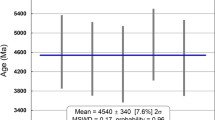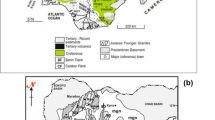Abstract
LA-ICPMS zircon U-Pb dating has been greatly advanced and widely applied in the past decade because it is a cheap and fast technique. The internal error of LA-ICPMS zircon U-Pb dating can be better than 1%, but reproducibility (accuracy) is relatively poor. In in order to quantitatively assess the accuracy of this technique, zircons from two dioritic rocks, a Mesozoic dioritic microgranular enclave (FS06) and a Neoproterozoic diorite (WC09-32), were dated independently in eight laboratories using SIMS and LA-ICPMS. Results of three SIMS analyses on FS06 and WC09-2 are indistinguishable within error and give a best estimate of the crystallization age of 132.2 and 760.5 Ma (reproducibility is ∼1%, 2RSD), respectively. Zircon U-Pb ages determined by LA-ICPMS in six laboratories vary from 128.3±1.0 to 135.0±0.9 Ma (2SE) for FS06 and from 742.9±3.1 to 777.8±4.7 Ma (2SE) for WC09-32, suggesting a reproducibility of ∼4% (2RSD). Uncertainty produced during LA-ICPMS zircon U-Pb analyses comes from multiple sources, including uncertainty in the isotopic ratio measurements, uncertainty in the fractionation factor calculation using an external standard, uncertainty in the age determination as a result of common lead correction, age uncertainty of the external standards and uncertainty in the data reduction. Result of our study suggests that the uncertainty of LA-ICPMS zircon U-Pb dating is approximately 4% (2RSD). The uncertainty in age determination must be considered in order to interpret LA-ICPMS zircon U-Pb data rationally.
Similar content being viewed by others
References
Andersen T. 2002. Correction of common lead in U-Pb analyses that do not report 204Pb. Chem Geol, 192: 59–79
Black L P, Kamo S L, Allen C M, et al. 2004. Improved 206Pb/238U microprobe geochronology by the monitoring of a trace-element-related matrix effect: SHRIMP, ID-TIMS, ELA-ICP-MS and oxygen isotope documentation for a series of zircon standards. Chem Geol, 205: 115–140
Chang Z S, Vervoort J D, McClelland W C, et al. 2006. U-Pb dating of zircon by LA-ICP-MS. Geochem Geophys Geosyst, 7: Q05009
Eggins S M, Kinsley L P J, Shelley J M M. 1998. Deposition and elemental fractionation processes during atmospheric pressure laser sampling for analysis by ICPMS. Appl Surf Sci, 127–129: 278–286
Froude D O, Ireland T R, Kinny P D, et al. 1983. Ion microprobe identification of 4100–4200 Myr-old terrestrial zircons. Nature, 304: 616–618
Fryer B J, Jackson S E, Longerich, H. 1993. The application of laser ablation microprobe-inductively coupled plasma-mass spectrometry (LAM-ICP-MS) to in situ (U)-Pb geochronology. Chem Geol, 109: 1–8
Gao Y Y, Li X H, Griffin W L, et al. 2014. Screening criteria for reliable U-Pb geochronology and oxygen isotope analysis in uranium-rich zircons: A case study from the Suzhou A-type granites, SE China. Lithos, 192–195: 180–191
Huang G C, Xia J L, Ding L X, et al. 2013. Stage division and origin of Tonglushan pluton in southeast Hubei Province: Evidence from zircon U-Pb ages and Hf isotopes (in Chinese). Geol China, 40: 1392–1408
Ireland T R, Williams I S. 2003. Considerations in Zircon Geochronology by SIMS. Rev Mineral Geochem, 53: 215–241
Jackson S E, Pearson N J, Griffin W L, et al. 2004, The application of laser ablation-inductively coupled plasma-mass spectrometry to in situ U-Pb zircon geochronology. Chem Geol, 211: 47–69
Klötzli U, Klötzli E, Günes Z, et al. 2009. Accuracy of laser ablation U-Pb zircon dating: Results from a test using five different reference zircons. Geostand Geoanal Res, 33: 5–15
Košler J, Sylvester P J. 2003. Present trends and the future of zircon in geochronology: Laser ablation ICPMS. Rev Mineral Geochem, 53: 243–274
Li Q L, Li X H, Liu Y, et al. 2010. Precise U-Pb and Pb-Pb dating of Phanerozoic baddeleyite by SIMS with oxygen flooding technique. J Anal At Spectrom, 25: 1107–1113
Li Q L, Li X H, Lan Z W, et al. 2013. Monazite and xenotime U-Th-Pb geochronology by ion microprobe: Dating highly fractionated granites at Xihuashan tungsten mine, SE China. Contrib Mineral Petrol, 166: 65–80
Li X H, Liang X, Sun M, et al. 2001, Precise 206Pb/238U age determination on zircons by laser ablation microprobe-inductively coupled plasma-mass spectrometry using continuous linear ablation. Chem Geol, 175: 209–219
Li X H, Liu Y, Li Q L, et al. 2009. Precise determination of Phanerozoic zircon Pb/Pb age by multicollector SIMS without external standardization. Geochem Geophys Geosyst, 10: Q04010
Li X H, Li W X, Wang X C, et al. 2010. SIMS U-Pb zircon geochronology of porphyry Cu-Au-(Mo) deposits in the Yangtze River Metallogenic Belt, eastern China: Magmatic response to early Cretaceous lithospheric extension. Lithos, 119: 427–438
Li X H, Tang G Q, Gong B, et al. 2013. Qinghu zircon: A working reference for microbeam analysis of U-Pb age and Hf and O isotopes. Chin Sci Bull, 58: 4647–4654
Li Z X, Li X H, Wartho J A, et al. 2010. Magmatic and metamorphic events during the early Paleozoic Wuyi-Yunkai orogeny, southeastern South China: New age constraints and pressure-temperature conditions. Geol Soc Am Bull, 122: 772–793
Liu X M, Gao S, Diwu C R, et al. 2007. Simultaneous in-situ determination of U-Pb age and trace elements in zircon by LA-ICP-MS in 20 μm spot size. Chin Sci Bull, 52: 1257–1264
Liu Y S, Hu Z C, Gao S, et al. 2008. In situ analysis of major and trace elements of anhydrous minerals by LA-ICP-MS without applying an internal standard. Chem Geol, 257: 34–43
Liu Y S, Gao S, Hu ZC, et al. 2010a. Continental and oceanic crust recycling-induced melt-peridotite interactions in the Trans-North China Orogen: U-Pb dating, Hf isotopes and trace elements in zircons of mantle xenoliths. J Petrol, 51: 537–571
Liu Y S, Hu Z C, Zong K Q, et al. 2010b. Reappraisement and refinement of zircon U-Pb isotope and trace element analyses by LA-ICP-MS. Chin Sci Bull, 55: 1535–1546
Ludwig K R. 2001. Users’ manual for Isoplot/Ex rev. 2.49. Berkeley: Berkeley Geochronology Center Special Publication 1a. 56
Ludwig K R. 2008. User’s Manual for Isoplot 3.6: A Geochronological Toolkit for Microsoft Excel. Berkeley: Berkeley Geochronology Center Special Publication. 4
Ludwig K R. 2009. SQUID 2: A User’s Manual, rev. 12. Berkeley: Berkeley Geochronology Center Special Publication. 5
Luigi A S, Gómez-Tuena A, Bernal J P, et al. 2010. U-Pb zircon geochronology with an integrated LA-ICP-MS microanalytical workstation: Achievements in precision and accuracy. Geostand Geoanalyt Res, 34: 5–18
Outridge P M, Doherty W, Gregoire D C. 1997. Ablative and transport fractionation of trace elements during laser sampling of glass and copper. Spectrochim Acta B, 52: 2093–2102
Paton C, Woodhead J D, Hellstrom J C, et al. 2010, Improved laser ablation U-Pb zircon geochronology through robust downhole fractionation correction. Geochem Geophys Geosyst, 11: Q0AA06
Schmitz M D, Kuiper K.F. 2013. High-precision geochronology. Elements, 9: 25–30
Song S G, Niu Y L, Wei C J, et al. 2010. Metamorphism, anatexis, zircon ages and tectonic evolution of the Gongshan block in the northern Indochina continent: An eastern extension of the Lhasa Block. Lithos, 120: 327–346
Stacey J S, Kramers J D. 1975. Approximation of terrestrial lead isotope evolution by a two-stage model. Earth Planet Sci Lett, 26: 207–221
Sun J F, Yang J H, Wu F Y, et al. 2010. Magma mixing controlling the origin of the Early Cretaceous Fangshan granitic pluton, North China Craton: In situ U-Pb age and Sr-, Nd-, Hf- and O-isotope evidence. Lithos, 120: 421–438
Tu X L, Zhang H, Deng W F, et al. 2011. Application of RESOlution in-situ laser ablation ICP-MS in trace element analyses (in Chinese). Geochemica, 40: 83–98
White L T, Ireland T R. 2012. High-uranium matrix effect in zircon and its implications for SHRIMP U-Pb age determinations. Chem Geol, 306: 78–91
Wiedenbeck M, Alle P, Corfu F, et al. 1995. Three natural zircon standards for U-Th-Pb, Lu-Hf, trace-element and REE analyses. Geostand Newslett, 19: 1–23
Williams I S. 1998. U-Th-Pb geochronology by ion microprobe. Rev Econ Geol, 7: 1–35
Williams I S, Cho D L, Kim S W. 2009. Geochronology, and geochemical and Nd-Sr isotopic characteristics, of Triassic plutonic rocks in the Gyeonggi Massif, South Korea: constraints on Triassic post-collisional magmatism. Lithos, 107: 239–256
Williams I S, Hergt J M. 2000. U-Pb dating of Tasmanian dolerites: A cautionary tale of SHRIMP analysis of high-U zircon. In: Woodhead J D, Hergt J M, Noble W P, eds. Beyond 2000: New Frontiers in Isotope Geoscience, Lorne, 2000. Abstracts and Proceedings. 185–188
Xie L W, Zhang Y B, Zhang H H, et al. 2008. In situ simultaneous determination of trace elements, U-Pb and Lu-Hf isotopes in zircon and baddeleyite. Chin Sci Bull, 53: 1565–1573
Yang Y N, Li Q L, Liu Y, et al. 2014, Zircon U-Pb dating by Secondary Ion Mass Spectrometry (in Chinese). Earth Sci Front, 21: 81–92
Zhang A M, Wang Y J, Fan W M, et al. 2010, LA-ICPMS zircon U-Pb geochronology and Hf isotopic compositions of Caledonian granites from the Qingliu area, southwest Fujian. Geotect Metal, 34: 408–418
Author information
Authors and Affiliations
Corresponding author
Electronic supplementary material
Rights and permissions
About this article
Cite this article
Li, X., Liu, X., Liu, Y. et al. Accuracy of LA-ICPMS zircon U-Pb age determination: An inter-laboratory comparison. Sci. China Earth Sci. 58, 1722–1730 (2015). https://doi.org/10.1007/s11430-015-5110-x
Received:
Accepted:
Published:
Issue Date:
DOI: https://doi.org/10.1007/s11430-015-5110-x




